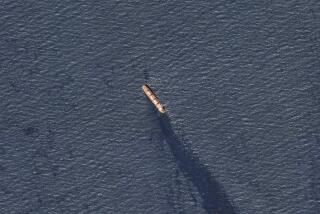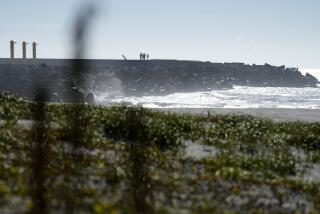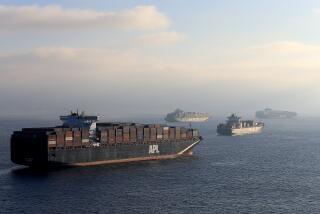Nations on Route of Japanâs Plutonium Ship Voice Fears : Safety: Possible leaks or terrorist raids could create danger as the cargo is moved from France.
TOKYO â Countries along the route of the Akatsuki Maru, a Japanese ship on its way to France to pick up a ton of plutonium, are objecting in growing numbers to having the deadly cargo transported through their back yards.
âWe think the proposed shipment of plutonium through Pacific waters poses a significant risk to us and to other Pacific peoples,â Bernard Dowiyogo, president of the tiny Pacific island republic of Nauru, told anti-nuclear activists who packed a small auditorium in Tokyo last weekend. âWe protest these shipments and call upon all involved countries--Japan, the U.S. and France--to desist.â
Representatives from the Northern Mariana Islands and Guam also appeared at the forum to express fears that the region, once the site of nuclear tests and atomic waste dumping, could now face environmental disaster--a leak of highly toxic plutonium--if there were an accident or terrorist attack on the ship.
Japanese officials have said the vessel will probably go around the Cape of Good Hope or Cape Horn and through the South Pacific.
Malaysia, Indonesia and Singapore have asked the Japanese government to forbid the ship to pass through the crowded Strait of Malacca. South Africa and Chile have warned that it will not be allowed in their territorial waters.
But Japan is not about to back down on its plutonium plans.
âThere is a lot of anxiety because people donât understand,â said Hiroyuki Kishino, director of the nuclear energy division at the Foreign Ministry. âIt is our responsibility to allay their fears.â
He said the shipment is a âtest caseâ for Japan. âFrom now, other shipments will occur, and we want to make a good precedent,â he said. âWe want to demonstrate that it can be done well.â
The trip did not begin well. The Akatsuki Maru left Japan on Aug. 24 with its escort ship, the armed cutter Shikishima. But the escort had to return twice, apparently for repairs.
Although the State Department has repeatedly expressed confidence in Japanâs ability to transport the plutonium safely, many countries question whether Japanâs safety measures are adequate.
Lorenzo I. De Leon Guerrero, governor of the Commonwealth of the Northern Mariana Islands, noted that the ocean near his nation can be as deep as 36,000 feet, at which depth the water pressure is a crushing seven tons per square inch. âIf the ship carrying plutonium sinks because of an accident or typhoon, will the plutonium containers hold up under that pressure?â he asked. âOr will they burst?â
A study backed by the Nuclear Control Institute and Greenpeace International estimated that containers used to transport the plutonium would begin to fail at a depth of 600 feet and would collapse at 11,000 feet. The same study noted that while the casks are designed to survive a temperature of 1,472 degrees, shipboard fires often exceed 2,000 degrees.
Security experts say the plutonium ship is also vulnerable to terrorist activity. âAll it would take is an Exocet missile shot from a fishing boat,â said Andrew Mack, professor of international relations at Australian National University. âYou sink the escort ship and take the container ship,â he said.
But Yoshikatsu Kato of the Science and Technology Agencyâs nuclear fuel division dismissed the danger of terrorist attack. âOnly a country could use a (missile), and in the current situation that is unthinkable,â he said.
The plutonium being shipped was extracted by a French reprocessing plant from Japanese spent fuel and will be used in an experimental breeder reactor that is to begin operation next spring. Japan has a contract to import 30 tons of plutonium over the next two decades for use in that breeder as well as in conventional light-water reactors.
Other nations, including the United States and Germany, have abandoned breeder reactor programs because of technical difficulties and because the plutonium is an environmental and security problem.
Japan is going ahead with plans to process its own plutonium from spent fuel by the end of the decade. That capability, combined with the breeder reactor, would let Japan eventually provide its own fuel to its growing battery of nuclear facilities and help it reach its goal of energy independence.
More to Read
Sign up for Essential California
The most important California stories and recommendations in your inbox every morning.
You may occasionally receive promotional content from the Los Angeles Times.










